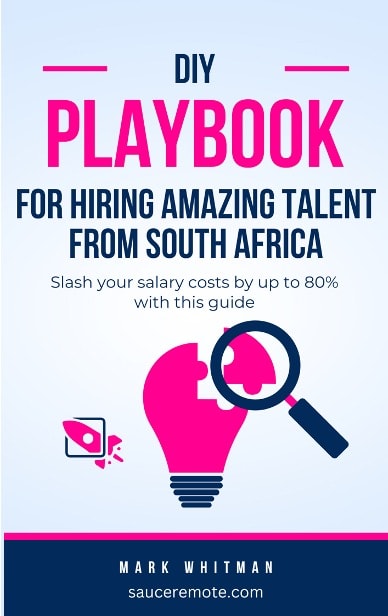If you've been searching for the difference between PEO and ASO, you've probably come across plenty of jargon without much clarity.
Let me simplify it.
PEO and ASO are both services that help businesses manage HR, but they do it in different ways.
Today, I’ll break down ASO vs PEO, so you can decide which one fits your needs best.
Ready? Let’s roll.

Discover how to slash your salary costs by 80%
Get our exact process for hiring amazing overseas talent from South Africa. Includes copy-and-paste templates and a detailed salary guide.
ASO vs PEO: The Differences Explained
Let’s start finding the differences by looking at an ASO.
What is an ASO?
An ASO (Administrative Services Organisation) provides support for HR functions.
For example, companies like ADP, Insperity, and TriNet offer ASO services that include payroll processing, benefits administration, and compliance assistance.
Each provider has unique offerings, such as Insperity's focus on personalised HR solutions and TriNet's industry-specific expertise.
They help with things like payroll, employee benefits, and compliance.
But, they don't act as a co-employer. And this is the main difference between an ASO and a PEO.
You still handle the core responsibilities of your employees.
So, an ASO is great for businesses that want to maintain control while getting extra help with the more tedious administrative tasks.
Hire remote talent from South Africa & slash salary costs by 80%
Salaries start from £8,000 per year!
What is a PEO?
A PEO (Professional Employer Organisation), on the other hand, takes on a bigger role.
When you work with a PEO, you're entering into a co-employment arrangement. This means the PEO shares certain legal responsibilities with you.
They help manage payroll, benefits, tax filings, and compliance. They also give you access to employee benefits you might not get on your own.
PEO services can be a game-changer for small to mid-sized companies looking to streamline their operations and compete with larger firms.
Now that we understand what each service is, lets look at when should you use a PEO or an ASO.
When to Use a PEO vs ASO
Here’s when to use a PEO or ASO:
- PEO: Best for businesses needing full HR support, better benefits, and wanting to share compliance responsibilities. Great for reducing risk.
- ASO: Ideal if you want to keep control but need support for payroll, benefits, or compliance. It’s the middle ground.
Sounds pretty straightforward, right?
Hold your horses. There are some complications. Let’s dive a bit deeper into the differences between PEOs and ASOs.
Hire remote talent from South Africa & slash salary costs by 80%
Salaries start from £8,000 per year!
The Limits of ASOs
ASOs offer more flexibility than PEOs, but they come with their own set of challenges.
Since an ASO doesn't take on co-employment, the business retains full liability for its employees.
This means you're still on the hook for compliance issues, which can be overwhelming if you don't have a dedicated HR expert on staff.
For a small retail business, this might mean scrambling to keep up with changing labour laws or struggling with complicated paperwork during tax season.
Another limitation is that ASOs provide support on an à la carte basis. This means that while you only pay for what you need, you also don't get the holistic, all-in-one service that a PEO offers.
The Limits of PEOs
While PEOs can provide tremendous value, they aren't without their drawbacks.
One of the biggest limitations is the loss of direct control.
By entering into a co-employment relationship, you share responsibilities with the PEO, which means some decisions—especially around employee benefits and compliance—are no longer entirely yours.
This can be a tough adjustment for business owners used to having the final say.
Take, for example, a small tech startup that joined a PEO to access better health benefits.
While the employees loved the improved coverage, the founders found the process of implementing company-specific HR policies cumbersome, as they had to navigate the PEO's standardised procedures.
The lack of flexibility ultimately made them feel disconnected from their workforce.
Now, another significant difference between an ASO and PEO is cost.
Hire remote talent from South Africa & slash salary costs by 80%
Salaries start from £8,000 per year!
How Much Does a PEO Cost?
The cost of a PEO can vary, depending on the provider and services offered. It’s often priced as a percentage of your total payroll (typically 2-12%) or a per-employee fee (ranging from $900 to $1,500 annually).
My pro tip: To understand more about this, check out my full guide on PEO cost.
How Much Does an ASO Cost?
The cost of an ASO is generally more flexible compared to a PEO.
ASO services are usually priced based on the specific services you need, making it more of an a la carte model.
For instance, costs can range from a flat fee per service to a per-employee, per-month fee, depending on the level of support.
Typically, ASO fees are lower than PEO because you're not entering into a co-employment relationship but rather paying for administrative support.
ASOs can be more cost-effective if you want to retain control over HR functions while getting help with specific tasks.
So, how do you know when to use which HR service? Let me explain.
PEO or ASO: Which One Do You Need?
If you're trying to choose between PEO vs. ASO, ask yourself this:
Do you want to share responsibility?
PEO could be for you if you're comfortable with that co-employer setup.
Plus, the PEO pros and cons are pretty straightforward—you get access to better employee benefits and reduced administrative burden, but you lose some direct control over HR processes.
You get big benefits and reduced administrative headaches, but you lose some direct control.
On the other hand, ASO is better if you want to keep your independence while getting help with the nitty-gritty.
But there are also other alternatives. Let’s explore some.
Hire remote talent from South Africa & slash salary costs by 80%
Salaries start from £8,000 per year!
PEO vs HRO and Other Alternatives
Still not sure? Maybe neither is right for you.
Have a look at my comparison of PEO vs HRO for another perspective.
Or if you need a more global solution, you might consider a PEO vs EOR arrangement. Each has unique benefits depending on the scale and needs of your business.
My Final Thoughts
And there you have it: Choosing between PEO vs ASO is all about your specific needs.
Do you want someone to step in and help share the load? Go with a PEO. Prefer to keep control but just need a little extra help? An ASO might be perfect for you.
Feel free to explore the pros and cons of both options to find what fits your company’s strategy best.
